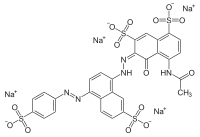This is an old revision of this page, as edited by CheMoBot (talk | contribs) at 13:47, 23 March 2011 (Updating {{chembox}} (no changed fields - added verified revid - updated 'UNII_Ref', 'ChemSpiderID_Ref', 'StdInChI_Ref', 'StdInChIKey_Ref', 'ChEMBL_Ref', 'KEGG_Ref') per Chem/Drugbox validation (). The present address (URL) is a permanent link to this revision, which may differ significantly from the current revision.
Revision as of 13:47, 23 March 2011 by CheMoBot (talk | contribs) (Updating {{chembox}} (no changed fields - added verified revid - updated 'UNII_Ref', 'ChemSpiderID_Ref', 'StdInChI_Ref', 'StdInChIKey_Ref', 'ChEMBL_Ref', 'KEGG_Ref') per Chem/Drugbox validation ()(diff) ← Previous revision | Latest revision (diff) | Newer revision → (diff) | |
| Names | |
|---|---|
| IUPAC name Tetrasodium (6Z)-4-acetamido-5-oxo-6-hydrazono]naphthalene-1,7-disulfonate | |
| Other names C.I. Food Black 1; 1743 Black; Black PN; Blue Black BN; Brilliant Acid Black; C.I. 28440; Certicol Black PNW; Cilefa Black B; E 151; Edicol Supra Black BN; Hexacol Black PN; L Black 8000; Melan Black; Xylene Black F | |
| Identifiers | |
| CAS Number | |
| 3D model (JSmol) | |
| ECHA InfoCard | 100.017.951 |
| E number | E151 (colours) |
| PubChem CID | |
| CompTox Dashboard (EPA) | |
SMILES
| |
| Properties | |
| Chemical formula | C28H17N5Na4O14S4 |
| Molar mass | 867.68 g/mol |
| Except where otherwise noted, data are given for materials in their standard state (at 25 °C , 100 kPa).
| |
Brilliant Black BN, Brilliant Black PN, Brilliant Black A, Black PN, Food Black 1, Naphthol Black, C.I. Food Brown 1, or C.I. 28440, is a synthetic black diazo dye. It is soluble in water. It usually comes as tetrasodium salt. It has the appearance of solid, fine powder or granules. Calcium and potassium salts are allowed as well.
When used as a food dye, its E number is E151. It is used in food decorations and coatings, desserts, sweets, ice cream, mustard, red fruit jams, soft drinks, flavored milk drinks, fish paste, lumpfish caviar and other foods.
It appears to cause allergic or intolerance reactions, particularly amongst those with an aspirin intolerance. It is a histamine liberator, and may worsen the symptoms of asthma.
It is one of the colourants that the Hyperactive Children's Support Group recommends be eliminated from the diet of children. It is banned in Canada, United States, Finland, Japan. It was banned in Norway until 2001 when it was unbanned due to trade relationships with other countries. However there is an informal agreement in place, whereby Norwegian manufacturers are not allowed to use E151 in food and sweets.